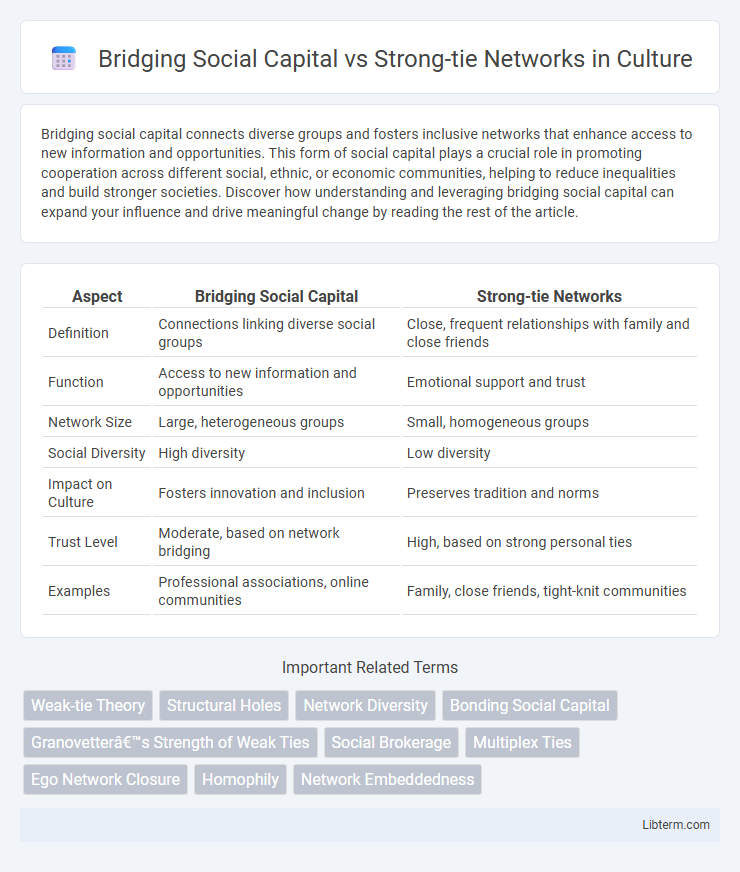Bridging social capital connects diverse groups and fosters inclusive networks that enhance access to new information and opportunities. This form of social capital plays a crucial role in promoting cooperation across different social, ethnic, or economic communities, helping to reduce inequalities and build stronger societies. Discover how understanding and leveraging bridging social capital can expand your influence and drive meaningful change by reading the rest of the article.
Table of Comparison
| Aspect | Bridging Social Capital | Strong-tie Networks |
|---|---|---|
| Definition | Connections linking diverse social groups | Close, frequent relationships with family and close friends |
| Function | Access to new information and opportunities | Emotional support and trust |
| Network Size | Large, heterogeneous groups | Small, homogeneous groups |
| Social Diversity | High diversity | Low diversity |
| Impact on Culture | Fosters innovation and inclusion | Preserves tradition and norms |
| Trust Level | Moderate, based on network bridging | High, based on strong personal ties |
| Examples | Professional associations, online communities | Family, close friends, tight-knit communities |
Understanding Bridging Social Capital
Bridging social capital refers to the connections that link individuals across diverse social groups, fostering access to new information, resources, and opportunities beyond close-knit circles. Unlike strong-tie networks, which consist of close, emotionally intense relationships such as family and close friends, bridging social capital spans weaker, more distant ties that are crucial for social integration and innovation. Understanding bridging social capital highlights its role in promoting social cohesion, enabling collaboration across different communities, and driving collective action through broader social inclusion.
Defining Strong-tie Networks
Strong-tie networks consist of close-knit relationships characterized by frequent interactions, emotional intensity, and trust, typically found among family members, close friends, and colleagues. These networks facilitate rapid information flow and provide strong social support but often lack diversity in perspectives. Compared to bridging social capital, which connects disparate groups and fosters access to novel resources, strong-tie networks emphasize depth and loyalty within homogeneous social circles.
Key Differences Between Bridging and Bonding Ties
Bridging social capital connects diverse groups, fostering inclusivity and access to new information, while strong-tie networks, representing bonding ties, emphasize close relationships and emotional support within homogenous groups. Bridging ties enhance opportunities through weak links that link across social divides, whereas bonding ties reinforce trust and solidarity among similar individuals. The key difference lies in their function: bridging ties expand social horizons, and bonding ties consolidate internal cohesion.
Social Network Theory: Bridging vs Strong Ties
Bridging social capital connects diverse social groups through weak ties, facilitating access to novel information and broader resources within social network theory. Strong-tie networks consist of close-knit relationships characterized by frequent interactions and emotional support, fostering trust and cooperation within homogenous groups. Understanding the balance between bridging and strong ties enables organizations to optimize knowledge exchange and community resilience.
Benefits of Bridging Social Capital
Bridging social capital connects diverse groups and individuals, fostering access to new information, resources, and opportunities beyond close-knit circles. This type of social capital enhances innovation, social cohesion, and community resilience by linking weak-tie networks that span different social, cultural, or professional backgrounds. Unlike strong-tie networks, bridging social capital supports broader collaboration and social mobility by bridging gaps between isolated groups.
Advantages of Strong-tie Networks
Strong-tie networks offer deep trust and emotional support, enhancing collaboration and resilience within close-knit groups. These connections facilitate efficient information exchange and reliable resource sharing, promoting stability in personal and professional relationships. Strong-tie networks often lead to increased loyalty and mutual aid, crucial for navigating challenges and achieving collective goals.
Challenges in Cultivating Bridging Social Capital
Cultivating bridging social capital faces challenges such as overcoming trust deficits between diverse groups and managing conflicting interests that hinder cooperation. Weak ties often lack the emotional intensity found in strong-tie networks, making sustained engagement difficult. Constraints in communication frequency and resource exchange reduce the potential benefits of these expansive social connections.
The Role of Trust in Different Social Ties
Trust plays a pivotal role in bridging social capital by facilitating connections across diverse social groups, enabling the flow of novel information and resources beyond close-knit circles. In strong-tie networks, trust is typically deep and personal, fostering emotional support and cooperation within homogeneous groups. The distinction in trust dynamics between bridging and strong-tie networks shapes how individuals leverage social capital for collective action and resource exchange.
Impact on Community Resilience and Innovation
Bridging social capital connects diverse groups, fostering inclusive networks that enhance community resilience by facilitating access to novel resources and information, which drives innovation and adaptive strategies. Strong-tie networks, composed of close-knit relationships, provide emotional support and trust essential for collective action during crises but may limit exposure to new ideas. Communities leveraging both bridging social capital and strong-tie networks optimize innovation opportunities and resilient responses, balancing trust with diversity of knowledge.
Strategies to Balance Bridging and Strong-tie Connections
Effective strategies to balance bridging social capital and strong-tie networks involve fostering diverse social interactions that connect individuals across different groups while maintaining close, trust-based relationships. Encouraging participation in community events and cross-group collaborations strengthens weak ties, expanding access to new information and opportunities. Simultaneously, prioritizing quality time and mutual support within close-knit networks preserves emotional bonds critical for resilience and social cohesion.
Bridging Social Capital Infographic

 libterm.com
libterm.com